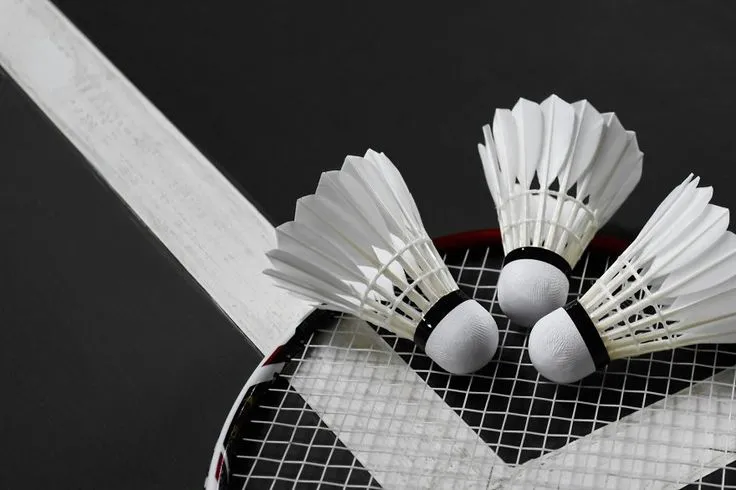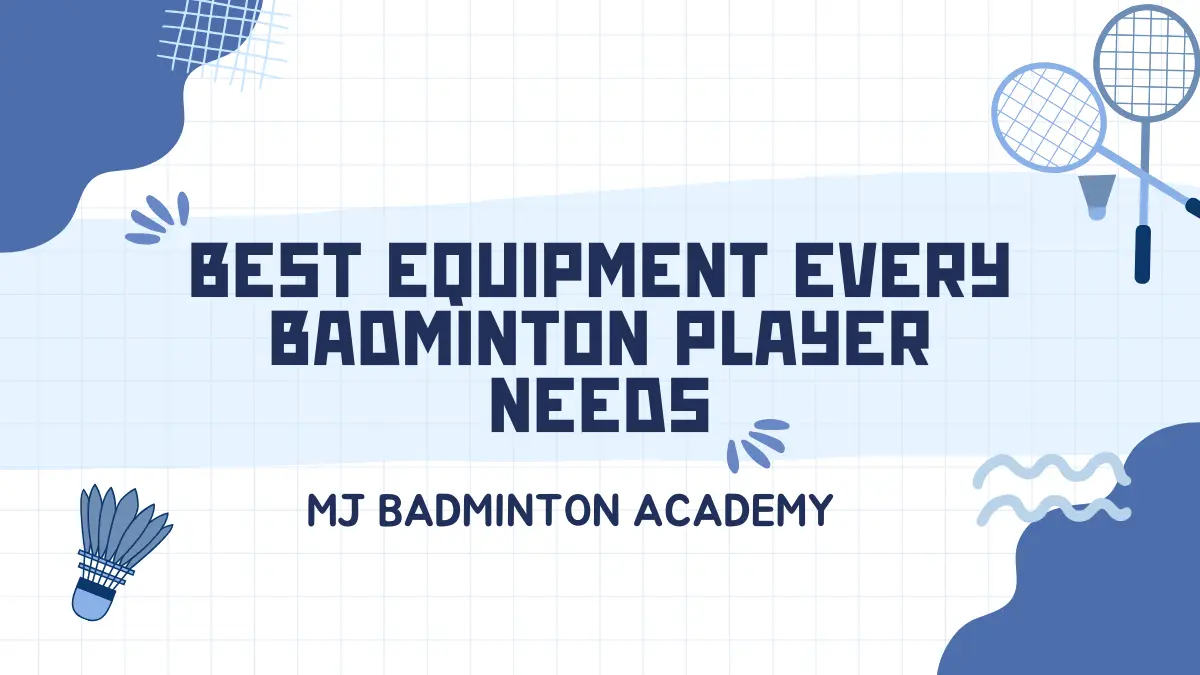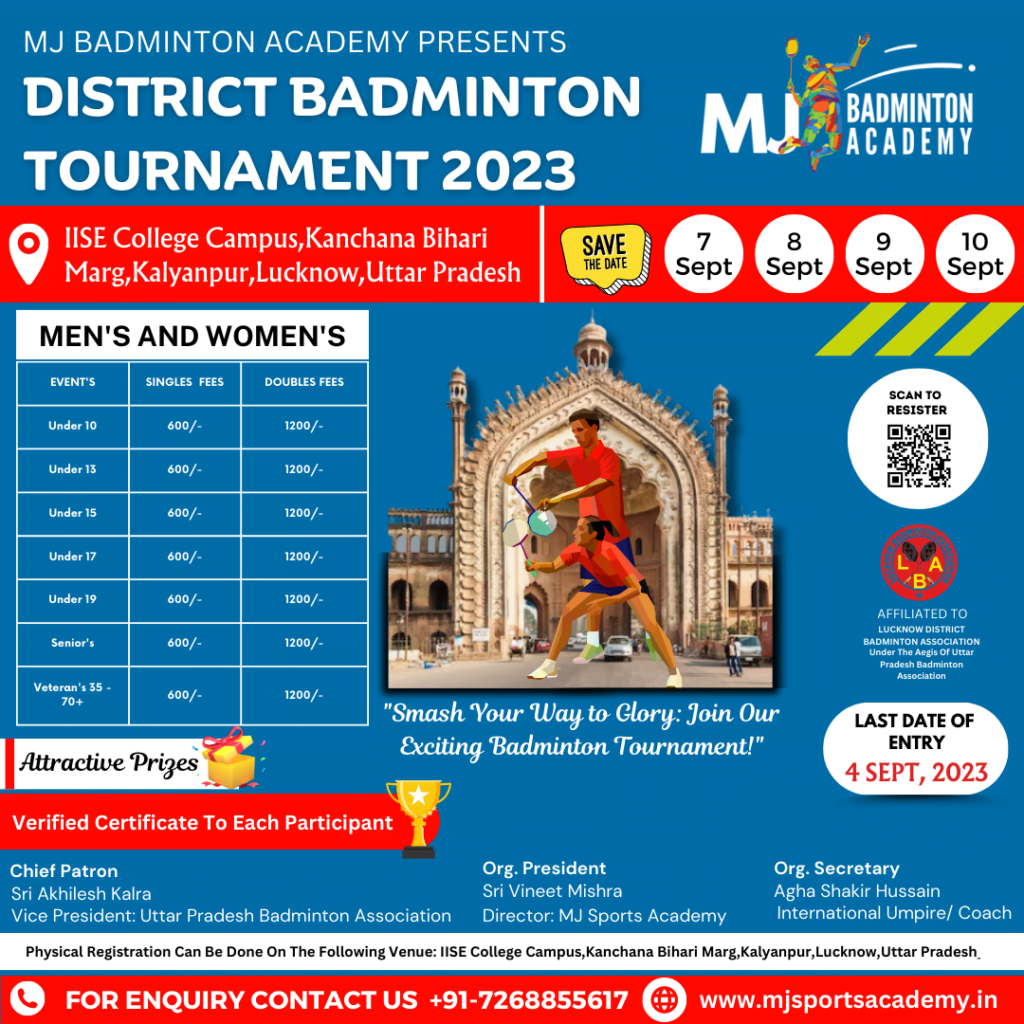Whether you’re a beginner at badminton or you’re an experienced player, the right gear is essential to improve your game, avoid injury, and have fun playing. At M.J. Sports Badminton Academy, we think that learning badminton is not only about technique—it’s also about the right equipment.
From shuttlecocks and rackets to the less-touted non-marking shoes and string tension, each component of your badminton equipment counts. In this in-depth guide, we’ll take you through what are the badminton equipment is and how to make smart purchases, and why M.J. Academy’s equipment tips can equip you like a pro.
Table of Contents
Choosing the Right Racket: Your Weapon on the Court
Your most critical gear is the badminton racket. It becomes part of your arm—enabling you to smash, drop, and defend.
Types of Badminton Rackets
Badminton rackets are available in different types according to:
- Balance: Head-heavy (for power), even-balanced (for versatility), and head-light (for speed).
- Weight: Lightweight rackets (approximately 80-85g) are perfect for speed and control, while heavier rackets (85-90g) provide more power.
- String tension: Greater tension provides greater control but demands high-level skills. Beginners can use lower tension (approximately 20-22 lbs), while professionals can use 24-28 lbs.


How to Choose the Best Racket for You
- Beginners: Opt for even-balanced, light rackets with medium tension strings.
- Intermediates: Select according to playing style—power or speed.
- Advanced players: Personalize from the grip size to string tension according to preference.
M.J. Sports Badminton Academy’s tip: We suggest players try out a few rackets before settling. Our coaches assist you in knowing which racket best fits your style and objectives.
Importance of Non-Marking Shoes: The Foundation of Movement
Badminton is a quick sport with rapid lateral movements, lunges, and rapid direction changes. Wearing the appropriate shoes is necessary to guard your feet and stay agile.
What are Non-Marking Shoes?
Non-marking shoes are specifically made for indoor courts. They have gum rubber soles that do not leave scuff marks on the floor and provide excellent grip and support.
Why Are They So Important?
- Ankle support: Minimizes the chance of sprains.
- Cushioning: Dampens impact when jumping and taking fast steps.
- Grip: Prevents slipping on smooth indoor courts.
Wearing normal running or gym shoes can cause injuries and decreased performance. At M.J. Sports Badminton Academy, all members are encouraged to purchase good-quality non-marking shoes from reputable brands such as Yonex, Li-Ning, or Victor.
Shuttle Types and Uses: Know Your Feathered Friends
The shuttlecock of badminton is the central focus of all rallies. Yet not all shuttlecocks are created equal.
Types of Badminton Shuttlecocks
- Feathered Shuttlecocks:
- Constructed of goose or duck feathers.
- Utilized in competitive play and professional instruction.
- Provide improved flight, spin, and feel.
- Shorter life span; more delicate with hard play.
- Synthetic (Nylon) Shuttlecocks:
- Constructed of plastic.
- Long-lasting and tough.
- Best for beginners and recreational play.
- Flight pattern slightly different from feathers.
When to Use Which?
- Feather shuttles: Best used for match play and developing touch and control.
- Nylon shuttles: Excellent for novices and warm-up practice.
M.J. Academy’s Equipment Tip: Store spare shuttlecocks in your badminton kit bag—you never know when you’ll need a new one. Practice using both to prepare for varying conditions of play.
Grips, Strings, and Bags: The Unsung Heroes
- Badminton Grips: Grips improve your grip on the racket and soak up sweat, so you don’t slip during long matches.
- Overgrips: Thinner, placed over existing grips for extra comfort.
- Replacement grips: Thicker, substitute the original grip.
- Towel grips: Excellent for sweaty palms, soak up moisture well.
Switch your grip often to keep control and hygiene. Try different textures and thicknesses to see what works best for you.
- Badminton Strings: Racket strings can both make and destroy your shot quality.
- Higher tension (24-28 lbs): More control, best for higher-level players.
- Lower tension (18-22 lbs): More power, less control, best for beginners.
- String types: Multifilament strings have excellent power and comfort; robust strings are best for heavy usage.
Inquire from your coach about restringing schedules—strings lose their tension over time and must be replaced periodically.
- Badminton Kit Bag: An orderly badminton kit bag keeps your equipment safe and within easy reach.
What to Store in Your Kit Bag:
- 2–3 rackets
- Shuttle tubes
- Extra grips and strings
- Non-marking shoes
- Towel
- Water bottle
- First aid kit
- Energy bars or electrolyte sachets
- Fresh pair of socks and badminton apparel
Choose for a bag with many compartments, ergonomic straps, and ventilated shoe pockets.
M.J. Sports Badminton Academy tip: Taking care of your equipment is as crucial as selecting the right one. Storage and maintenance matter a lot.
Badminton Apparel: Dress to Perform
Comfortable and functional clothing is necessary for top performance on court.
What to Wear?
- T-shirts: Lightweight, breathable, and sweat-wicking fabrics.
- Shorts/Skirts: Roomy and stretchy, with sufficient space for lunges and stretches.
- Socks: Cushioned and sweat-absorbing to prevent blisters.
- Wristbands/headbands: Prevents sweat from reaching your eyes and hands.
At M.J. Sports Badminton Academy, we also advocate wearing jerseys for inter-academy games to enhance a professional playing attitude.
M.J. Academy’s Equipment Advice: Gear Up Like a Pro
At M.J. Sports Badminton Academy, we don’t merely train players—we prepare them in all aspects, and that’s including informing them about the proper badminton gear. Here’s how we assist players in making sound gear decisions:
- Personalized Equipment Consultation: Our coaches instruct you on:
- Selection of racket based on playing style.
- Optimum string tension.
- Shoe fitting and grip.
- Types of shuttlecock for training and matches.
- Exclusive Access to Partner Stores: We’ve partnered with leading sports stores where our players get:
- Discounted rates on genuine products.
- Expert assistance from trained staff.
- Priority on new arrivals and seasonal offers.
- Regular Gear Check Sessions: We hold regular gear-check sessions where:
- We check your racket strings and grips.
- Check your shoes for excessive wear and tear.
- Make sure your badminton kit bag is fully stocked.
We consider badminton clothing, equipment, and accessories to be the building blocks of every winning player’s career. Our academy teaches you not just how to win—but how to do it equipped with the best tools.
FAQs related to badminton equipment
What are the badminton equipments every player should own?
A full complement of badminton gear consists of:
1. A suitable badminton racket
2. Badminton shuttlecocks made of feather or nylon
3. Non-marking indoor court shoes
4. Non-marking indoor court shoes
5. A working badminton kit bag
6. Comfortable badminton apparel like T-shirts, shorts, and socks
Here at M.J. Sports Badminton Academy, we assist players in choosing each item depending on their playing level and style.
How do I choose the right badminton racket for myself?
The decision is based on your level of skill and playing style. Novices might use a lightweight, even-balanced racket with medium string tension, whereas professionals may use a head-heavy racket to deliver strong smashes. Our coaches at M.J. Sports Badminton Academy provides one-on-one assistance to guide you to your ideal match.
Why are non-marking shoes essential for badminton?
Non-marking shoes are specifically created for indoor courts. They offer:
1. Improved grip on slippery court surfaces
2. Ankle support to minimize the risk of injury
4. Shock absorption in case of high-impact movements
Wearing running or training shoes can cause slips and injuries. That’s why M.J. Academy suggests investing in quality badminton-specific shoes.
What are the different types of badminton shuttlecocks, and when should I use them?
Two forms of badminton shuttlecocks exist:
1. Feathered shuttlecocks: Tournaments, offer finer control and flight but are shorter-lived.
2. Synthetic/Nylon shuttlecocks: Durable and suitable for practice sessions or novices.
Both are employed at M.J. Sports Badminton Academy depending on the intensity of the training and what one wants out of a session.
What should I keep in my badminton kit bag?
Your badminton kit bag must contain:
1. 2–3 rackets
2. Spares of shuttlecocks
3. Replacement grips
4. String reel (optional)
5. Non-marking shoes
6. A towel, water bottle, and snacks
7. A change of badminton clothing
Having your gear in order enhances your preparedness and performance.
Final Thoughts
So, what are the badminton gear that every player needs? The response is more than just rackets and shuttles. It is all about finding the ideal set of equipment that suits your game style, experience, and comfort.
From knowing your racket tension to opting for the finest badminton shuttlecocks, caring for your badminton kit bag, and wearing top-quality badminton wear, every little detail counts.
At M.J. Sports Badminton Academy, we’re dedicated to crafting champions on and off the court. The right mindset begins with the right equipment—let us help you build both.
Ready to Level Up Your Game?
Visit M.J. Sports Badminton Academy today to get expert coaching and personalized equipment guidance. We’re not just training players—we’re creating badminton warriors.
Join us. Gear up. Smash harder.



